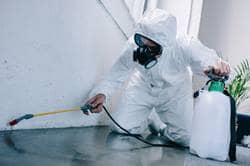Lessons from losses – pest control worker safety

By: Courtney Rosengartner
Sr. Risk Solutions Specialist
A pest control worker falls on ice outside a customer’s residence. Meanwhile, another pest control worker trips and falls down the stairs at a client’s home. At a different company, a pest control worker sustains heat exhaustion working outdoors in heavy equipment. Furthermore, various other pest control employees get hurt while completing work, commonly due to slips and falls from heights and same level surfaces.
Pest control workers have one of the highest rates of injuries and illnesses of all occupations (bls.gov). Injuries may occur when driving to job sites, while being exposed to weather conditions, from inadequate personal protective equipment, from a fall, and while exposed to harmful chemicals, rodents, snakes or insects. Pest control workers may also experience strains and sprains from kneeling, bending, crawling into narrow spaces, and lifting equipment.
The following includes some tips to mitigate injuries to pest control workers:
- Develop a workplace safety program that includes safety training, regular safety meetings, and addresses potential hazards
- Develop a personal protective equipment program that requires appropriate gear when working with pesticides; including proper clothing, gloves, goggles, and respirators
- Develop a respiratory program that includes regular fit testing
- Develop a hazard communication program
- Develop a fall protection and ladder safety program
- Develop a program for working in confined space that addresses adequate lighting conditions
- Develop a fleet safety and driver safety program that includes a cell phone policy that prohibits driving while using mobile devices
- Develop a heat illness prevention program that provides for routine breaks for water
- Develop a material handling program that addresses proper lifting and using handcarts or other lifting tools
The above is not an exhaustive list of items covering pest control worker safety. You may wish to seek professional and legal advice for comprehensive safety guidance.
Source: US Bureau of Labor Statistics (bls.gov)

This "document” is intended for general information purposes and should not be construed as advice or opinions on any specific facts or circumstances. The content of this document is made available on an “as is” basis, without warranty of any kind. This document cannot be assumed to contain every acceptable safety and compliance procedure or that additional procedures might not be appropriate under the circumstances. Markel does not guarantee that this information is or can be relied on for compliance with any law or regulation, assurance against preventable losses, or freedom from legal liability. This publication is not intended to be legal, underwriting, or any other type of professional or technical advice. Persons requiring advice should consult an independent adviser or trained professional. Markel does not guarantee any particular outcome and makes no commitment to update any information herein, or remove any items that are no longer accurate or complete. Furthermore, Markel does not assume any liability to any person or organization for loss or damage caused by or resulting from any reliance placed on this content.
Markel® is a registered trademark of Markel Group Inc.
© 2023 Markel Service, Incorporated. All rights reserved.
